Logic Tutorial: Creating Warmth With Chorus
In this latest Logic Tutorial Mark Cousins investigates how use of chorus and flange plug-ins can add warmth and stereophonic width to a range of different sounds. Let’s start at the beginning.. Although we nowadays associate ‘warmth’ with something of analogue origin, it’s worth remembering that one of the most common techniques of […]
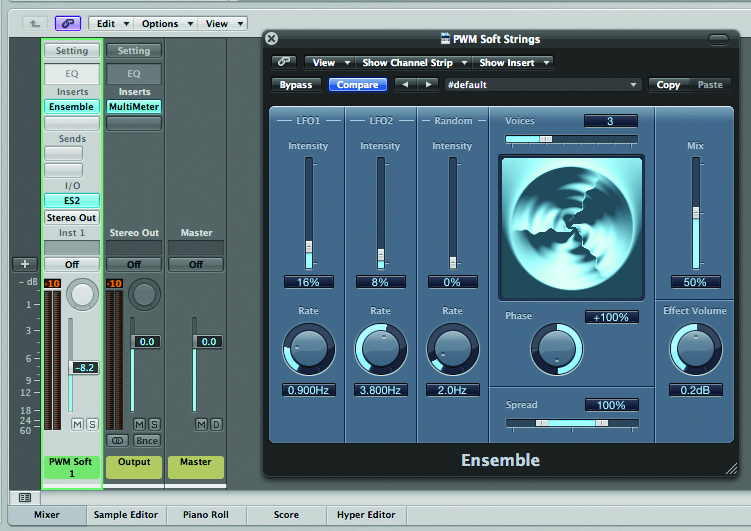
In this latest Logic Tutorial Mark Cousins investigates how use of chorus and flange plug-ins can add warmth and stereophonic width to a range of different sounds. Let’s start at the beginning..

Although we nowadays associate ‘warmth’ with something of analogue origin, it’s worth remembering that one of the most common techniques of adding tangible warmth and stereo width to a signal is good, old-fashioned chorus.
Indeed, strip away the built-in chorus effects from many classic 80s string machines and you’re often left with a buzzy collection of sawtooth waves. In the plug-in world, chorus often seems to be overlooked, but when used correctly it can add a unique cinematic width to a range of sounds, from electric guitar to the aforementioned string pads.
In this tutorial we’re going to explore what’s available chorus-wise in Logic Pro, from the relative simplicity of the Chorus plug-in to the Scanner Vibrato, Flanger, 12-pole Phasing and Ensemble plug-ins.
Dawn Chorus
For the purposes of this exercise we’re going to use a simple PWM synth pad sound created on the ES2. Of course, the ES2 has its own built-in Chorus, Flanger and Phaser controls, but our objective here is to explore a more controlled and versatile execution of these important ‘thickening’ effects. Of course, if you’re using a virtual instrument without these built-in chorus effects you’ll need to turn to Logic’s Modulation plug-ins as a means of creating this flattering additional warmth and movement.
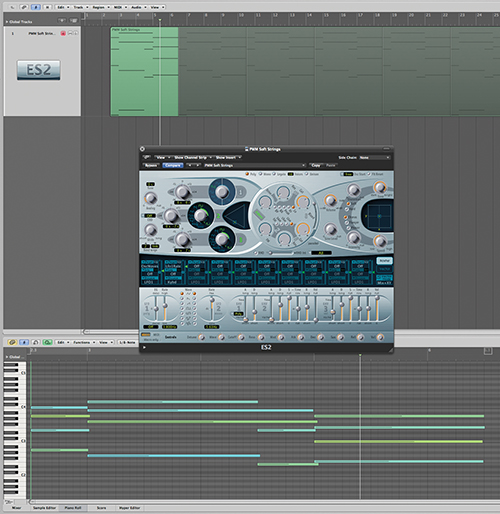
Arguably the easiest way of adding warmth to your mix is to use the Chorus plug-in, found in Logic’s Modulation Plug-ins folder. Technically speaking, chorus was originally created as an electronic means of achieving a thicker sound – the difference between a single violin player and a whole violin section playing in unison. In the real world, the added warmth is created by small pitch and timing variations between the players. In the electronic world, however, chorus is created my modulating the delay time on a number of discrete delay taps, effectively creating slightly out-of-tune duplicates of the original sound.
Arguably the best way of understating Logic’s Chorus plug-in is to start with some relatively ‘maxed-out’ settings. To begin with, raise the Intensity and Mix controls to their maximum positions, but keep the speed of the LFO – labelled Rate – relatively modest (around 0.166Hz). Play back the pad sound both with the effect enabled and then disabled. Set in this way, Chorus adds maximum stereo width thanks to the levels of both the Intensity and Mix controls. Push the LFO too hard, though, and the effect turns into an unpleasant trill-like sound.
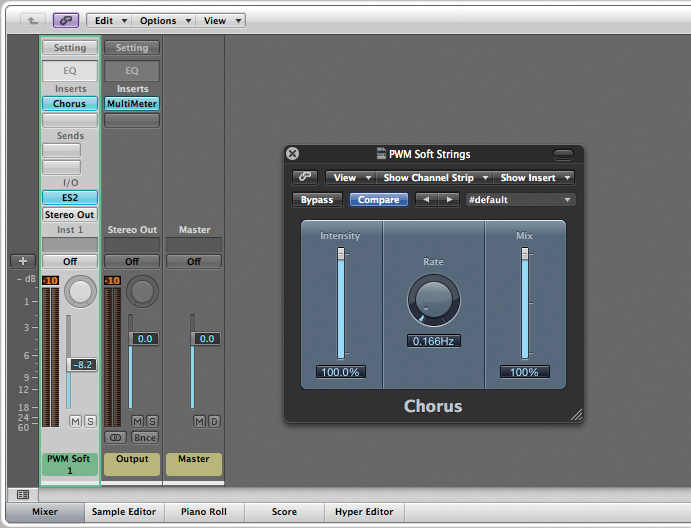
Going Wide
Although this ‘maximum width’ setting sounds interesting, it’s often worth taming the chorus effect slightly so that it doesn’t become too overbearing. Try reducing either the Mix or Intensity control, which should reduce the effect to a more moderate level. As you reduce the Intensity control, it’s interesting to start experimenting with faster Rate settings. On the whole, the principle seems to juxtapose the two settings – either using lots of Intensity with a slow Rate, or a faster Rate with less Intensity.
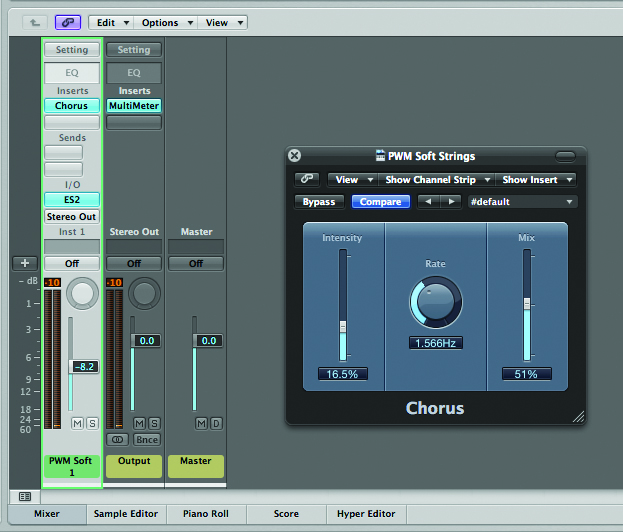
When it comes to variations on the chorus effect, Logic is packed with interesting candidates. One lo-fi alternative is the Scanner Vibrato plug-in, which is lifted from the signal path of the EVB3. The original Scanner Vibrato was a primitive electromechanical effect, employing a spinning pickup and a multi-pole capacitor to create a unique form of lo-fi vibrato and chorus. Try instantiating the Scanner Vibrato over our ES2 patch instead of the current Chorus effect. Notice how the effect instantly makes the ES2 sound like a vintage 70s string machine, which is a great alternative to the smooth and clean sound of the Chorus plug-in.
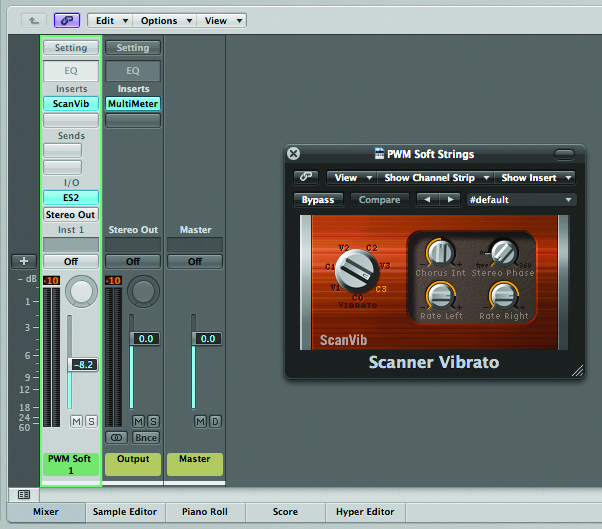
To fully appreciate what you can achieve with the Scanner Vibrato plug-in, try moving between the six positions settings (V1, C1, V2, C2 etc), which essentially switches between variations of either chorus or vibrato. The C settings give the familiar warm injection of chorus, with the Chorus Int control setting the relative intensity. Move to the vibrato positions, though, and the effect takes on a distinctly ‘wobbly’ quality. Try experimenting with different LFO rates (Rate Left and Rate Right), contrasting a fast setting on one side with a slow setting on the other.
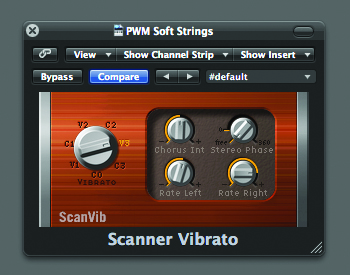
Flange Fun
Electronically speaking, flange is a similar effect to chorus, albeit with a markedly different sound. Remove the Scanner Vibrato plug-in, therefore, and switch to the Flanger plug-in to hear its unique sound. Notice the number of parameters shared with the Chorus plug-in – Speed, Intensity and Mix – plus one important additional control: Feedback. In effect, flange is produced in the same way as chorus, except the delay times are shorter and the output is subsequently fed back into the input. Try raising Feedback and notice how the effect takes on a distinctive ‘ringing’ quality.
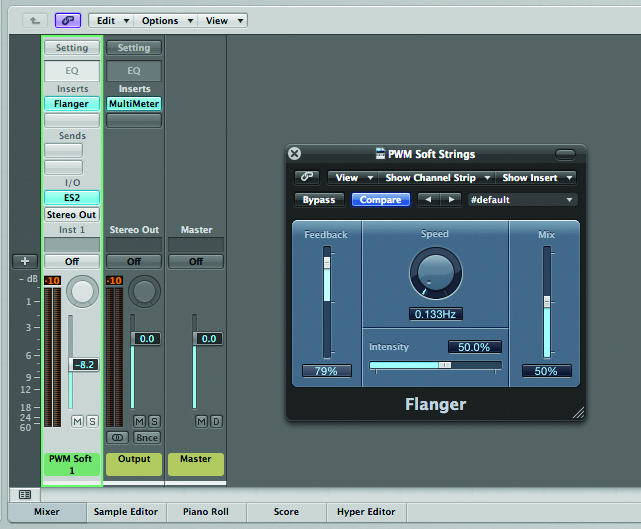
On the whole, flange parameters tend to be set up in one of two ways. The first is a Flanger sweep with a pronounced amount of Feedback. Try increasing Feedback to around 80%, therefore, and set Speed and Intensity low (0.166Hz and 4.5% respectively). The effect is a long, sweeping flange, with the sweeps lasting almost a full bar or more in duration. Another approach, which is more akin to chorus, is to lower the Feedback to around 21% and increase both the Speed and Intensity (1.533Hz and 10% respectively). This faster flange is much more appropriate as a warming effect, arguably making it a much more useful treatment for general mixing activities.
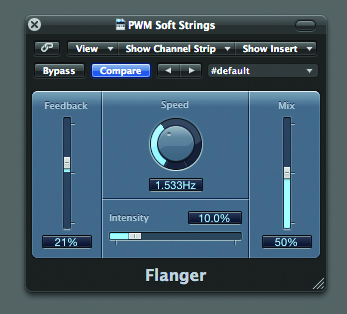
New Phase
If you like the sweeping effect of flange it’s worth taking a closer look at the Phaser plug-in. Rather than modulating delay time, a phaser manipulates the relative phase between two signals, creating a pronounced comb-filtering effect that notches out large parts of the frequency spectrum. Working from the default setting, therefore, try experimenting first with the Order setting, which effectively sets the strength of the comb-filtering effect. Contrast the 4 and 12 Order settings to hear the difference, and also notice how the odd-numbered settings tend to produce a far more subtle phasing.
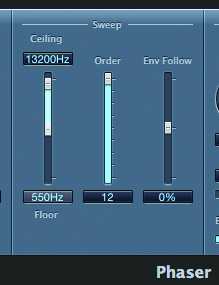
One of the key qualities of the Phaser plug-in is in the movement of the LFO, which creates the distinctive sweeping through the frequency spectrum. What’s interesting here is that you have two LFOs to play with, and they can be combined to create some interesting hybrid movements.
To understand what’s going on, try moving the LFO Mix control to either side of its centre position. Set in this way you can audition the two speeds of the LFOs. Try setting one LFO to a slow speed and the other to a faster speed, then repositioning the Mix control to create a combination of the two movements.
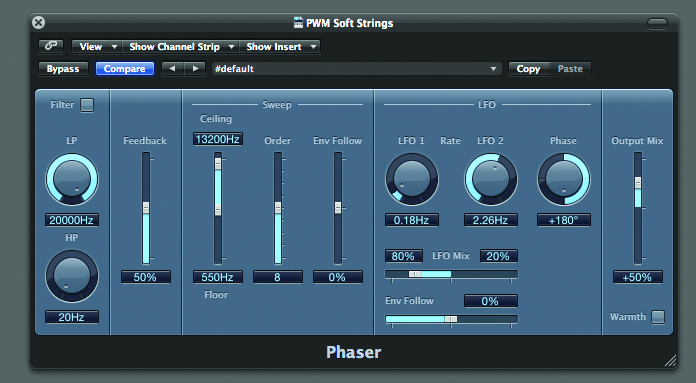
Next Dimension
If it’s super-size warmth you’re after, the Ensemble effect is chorus on steroids – much like the extremely lush sounds you can achieve with Roland’s Dimension D. The key to the warmth that the Ensemble plug-in creates is the number of voices used to generate the effect, from a single voice for chorus-like treatments to a full eight voices for swirling, dense chorus effects.
Working from the initialised setting, therefore, increase the Phase to +100% (this gives the effect more depth), the Mix to around 50% and move between the different voice settings. Sometimes a few voices can be just as effective as the full eight, so find the setting that suits your tastes.

The complexity and interest of the Ensemble effect is defined by the two LFOs and the Random modulator. In setting the LFOs, take the approach that we discovered with the Chorus plug-in – either pairing lots of Intensity with low Rates, or a low Intensity with a medium to fast Rate. The beauty here, though, is that we can have both extremes, arguably creating a super-thick chorus treatment. As you would expect, the Random section introduces a degree of uncertainty, which in small amounts makes the effect sound slightly less artificial and much closer to the natural ‘beating’ of two instruments that re slightly out-of-tune with one another.
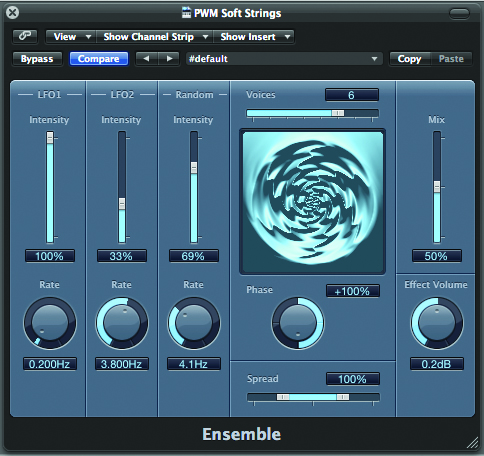
If you want to add a real sense of dimension to your sound, take a closer look at the Ensemble plug-in’s Spread control. The Spread control determines how the various voices are distributed across the stereo soundstage. At the centre position the output is completely monaural, while at the 100% setting the distribution spans the full width of the soundstage. Interestingly, the Spread can actually go as far as 200%, at which some of the voices are positioned beyond the usual boundaries of the stereo soundstage. Beyond 100%, though, there is a risk of losing mono compatibility, but this might be a price worth paying if a super-wide effect is what you’re after.
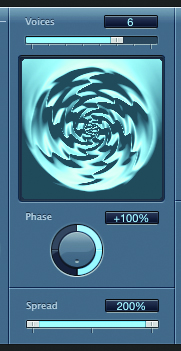
Super Stereo
Moving beyond the examples of processing a synth pad sound, it’s worth exploring the application of plug-ins such as Chorus, Flange and Ensemble on a number of different sounds, especially those that lack stereo information. When used in moderation, all of these techniques can be an interesting way of adding stereo dimensionality to any monaural sound source – including lead vocals and acoustic guitars – especially when the mix level is kept at a relatively conservative level so that the effect doesn’t become too discernible. More than just adding warmth, therefore, chorus and its associated effects can be powerful tools for a range of mixing applications.
